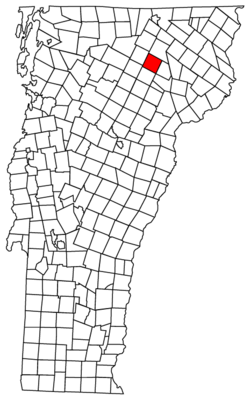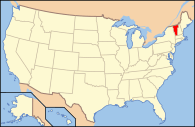Glover, Vermont facts for kids
Quick facts for kids
Glover, Vermont
|
|
|---|---|
|
Town
|
|

Glover Hall
|
|

Located in Orleans County, Vermont
|
|

Location of Vermont with the U.S.A.
|
|
| Country | United States |
| State | Vermont |
| County | Orleans |
| Chartered | November 20, 1783 |
| Named for | John Glover |
| Communities |
|
| Area | |
| • Total | 38.6 sq mi (100.0 km2) |
| • Land | 37.9 sq mi (98.1 km2) |
| • Water | 0.7 sq mi (1.9 km2) |
| Elevation | 945 ft (507 m) |
| Population
(2020)
|
|
| • Total | 1,114 |
| • Density | 30/sq mi (11.4/km2) |
| • Households | 446 |
| • Families | 282 |
| Time zone | UTC-5 (EST) |
| • Summer (DST) | UTC-4 (EDT) |
| ZIP Codes |
05839 (Glover)
05875 (West Glover) |
| Area code(s) | 802 |
| FIPS code | 50-28075 |
| GNIS feature ID | 1462103 |
Glover is a town in Orleans County, Vermont, in the United States. In 2020, the town's population was 1,114 people. It includes two smaller villages, Glover and West Glover.
The town is named after Brigadier General John Glover. He was a hero who served in the American Revolutionary War. He was also the main owner of the land when the town was first created.
Glover is home to three interesting museums. These are the Bread & Puppet Museum, the Glover Historical Society museum, and The Museum of Everyday Life.
Contents
Geography of Glover
Glover covers an area of about 38.6 square miles (100.0 km2). Most of this area, 37.9 square miles (98.1 km2), is land. The rest, 0.7 square miles (1.9 km2), is water.
The land in Glover is not flat. It has many hills and valleys. The highest point in town is Black Hills, which is 2,258 feet (688 m) high. This hill is located in the southern part of Glover.
Water flows in different directions from Glover. Some rivers flow northward, like branches of the Barton River. Other rivers flow southward, including branches of the Passumpsic, Lamoille, and Black Rivers. These rivers all start in Glover.
There are also four large ponds in the town. These are Parker Pond in the north, Clark's Pond in the center, and Sweeney Pond in the west. The fourth pond is Shadow Lake. Shadow Lake was first called Chambers Pond, then Stone Pond around 1822. In 1922, it was given its current name. The Abenaki people, who lived here long ago, called it Pekdabowk, which means Smoke Pond.
History of Glover
Early Education
In 1802, the people of Glover decided to build their first school. This school was located in the Parker settlement. They set a budget of $20 for the school's operating costs that year. By 1851, there were 450 students attending grammar school. However, by 2017, the number of students at that level had dropped to about 100.
The Runaway Pond
A major natural event happened in Glover on June 6, 1810. The banks of a pond called Long Pond broke open. This caused a huge flood that rushed down the Barton River valley. This event was the biggest natural disaster in Orleans County's history after European settlement. A brave worker named Spencer Chamberlain ran ahead of the flood. He warned people at the mill, saving many lives. After this event, Long Pond became known as "Runaway Pond" forever.
Slab City Settlement
From the 1820s to the 1930s, there was a small community called Slab City. It was located near the outlet of Shadow Lake. This settlement's economy depended on logging and three sawmills in the area. Slab City also had a lime kiln, a factory for making butter tubs, and a cider mill. There was also a one-room schoolhouse, a post office, a church, and other small businesses.
In 1836, a lawsuit was filed against the height of a dam. This dam held back water to power the sawmills. People were worried because of the earlier Runaway Pond disaster. The lawsuit was successful, and the dam's power was reduced. This marked the beginning of the end for Slab City.
West Glover's Infrastructure
The village of West Glover had a sewage system that stopped working in 2008. A new system was built in 2012 to replace it. This new system connected to the main sewage line in Glover village. That line then connected to the wastewater treatment plant in the nearby village of Barton. The USDA Rural Development Agency helped pay for this project.
Population and People
| Historical population | |||
|---|---|---|---|
| Census | Pop. | %± | |
| 1800 | 36 | — | |
| 1810 | 387 | 975.0% | |
| 1820 | 549 | 41.9% | |
| 1830 | 902 | 64.3% | |
| 1840 | 1,119 | 24.1% | |
| 1850 | 1,137 | 1.6% | |
| 1860 | 1,244 | 9.4% | |
| 1870 | 1,178 | −5.3% | |
| 1880 | 1,055 | −10.4% | |
| 1890 | 970 | −8.1% | |
| 1900 | 891 | −8.1% | |
| 1910 | 932 | 4.6% | |
| 1920 | 826 | −11.4% | |
| 1930 | 860 | 4.1% | |
| 1940 | 788 | −8.4% | |
| 1950 | 727 | −7.7% | |
| 1960 | 683 | −6.1% | |
| 1970 | 649 | −5.0% | |
| 1980 | 843 | 29.9% | |
| 1990 | 820 | −2.7% | |
| 2000 | 966 | 17.8% | |
| 2010 | 1,122 | 16.1% | |
| 2020 | 1,114 | −0.7% | |
| U.S. Decennial Census | |||
As of the 2020 census, Glover had a population of 1,114 people. In 2000, there were 966 people living in the town. There were 384 households and 269 families. The average household had about 2.40 people. The average family had about 2.83 people.
The population was spread out by age. About 22.0% of the people were under 18 years old. About 14.6% were 65 years or older. The average age in the town was 44 years old. For every 100 females, there were 100.0 males.
Economy
Income in Glover
In Glover, the average income for a household was $46,167. This means that half of the households earned more than this amount, and half earned less. The average income for each person in the town was $15,112. About 11.9% of all people in Glover lived below the poverty line. This included 15.2% of those under 18 and 14.9% of those 65 or older.
Second Homes
Glover has a high number of second homes. It ranks second in Orleans County for the highest percentage of homes that are owned as vacation or second residences.
Transportation
Main Roads
Town Roads
Glover has about 40 miles (64 km) of dirt roads. These roads lose a lot of gravel each year, about 11,720 cubic yards (8,960 m3). This gravel needs to be replaced regularly to keep the roads in good condition.
Notable People
Some well-known people have lived in Glover:
- Stephen Bliss, a Presbyterian minister and a member of the Illinois Senate.
- Emory A. Hebard, who served in the Vermont House of Representatives and as the Vermont State Treasurer.
- Charles Clark Jamieson, a brigadier general in the U.S. Army.
- Peter Schumann, who founded and directs the famous Bread & Puppet Theater.
See also
 In Spanish: Glover (Vermont) para niños
In Spanish: Glover (Vermont) para niños

